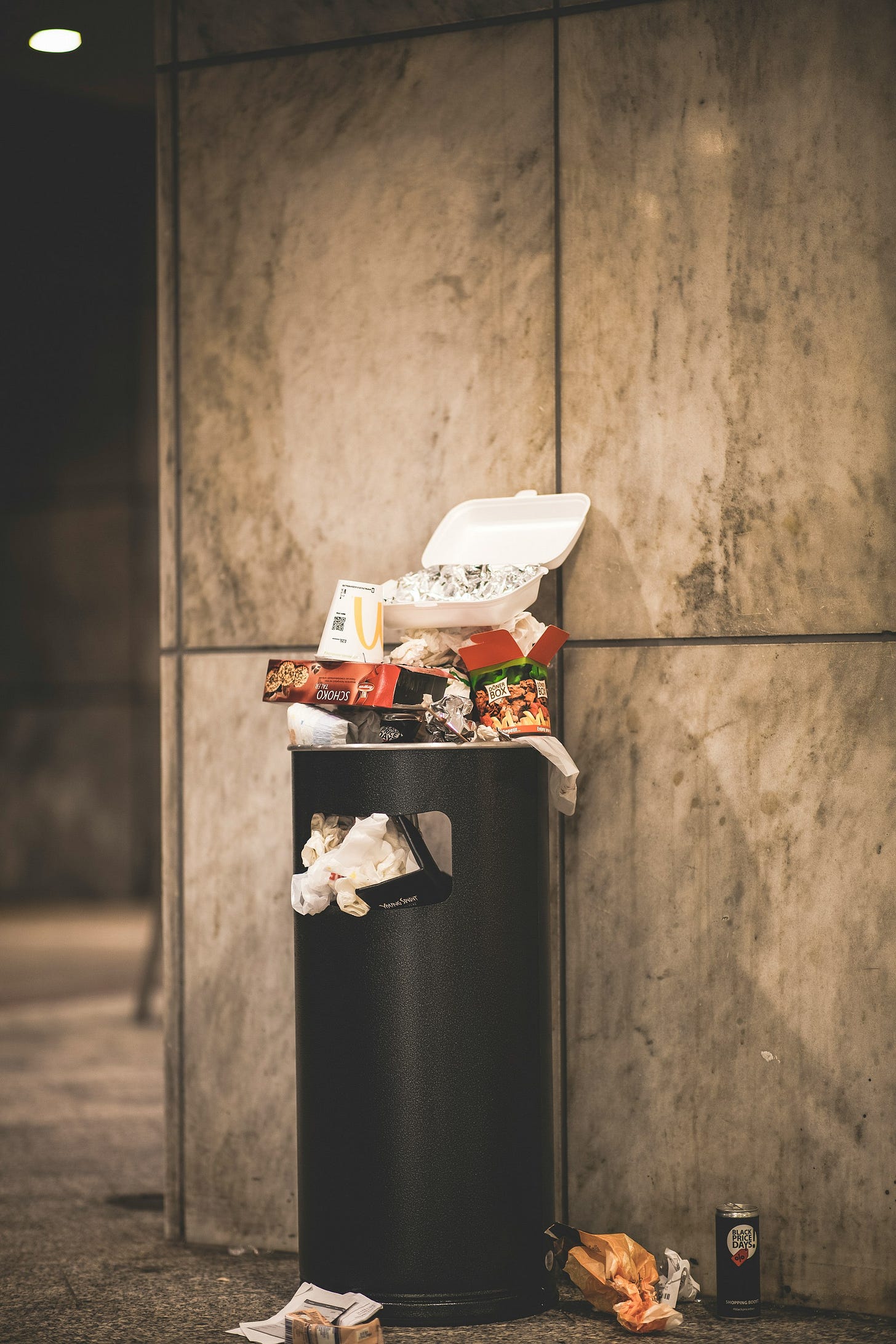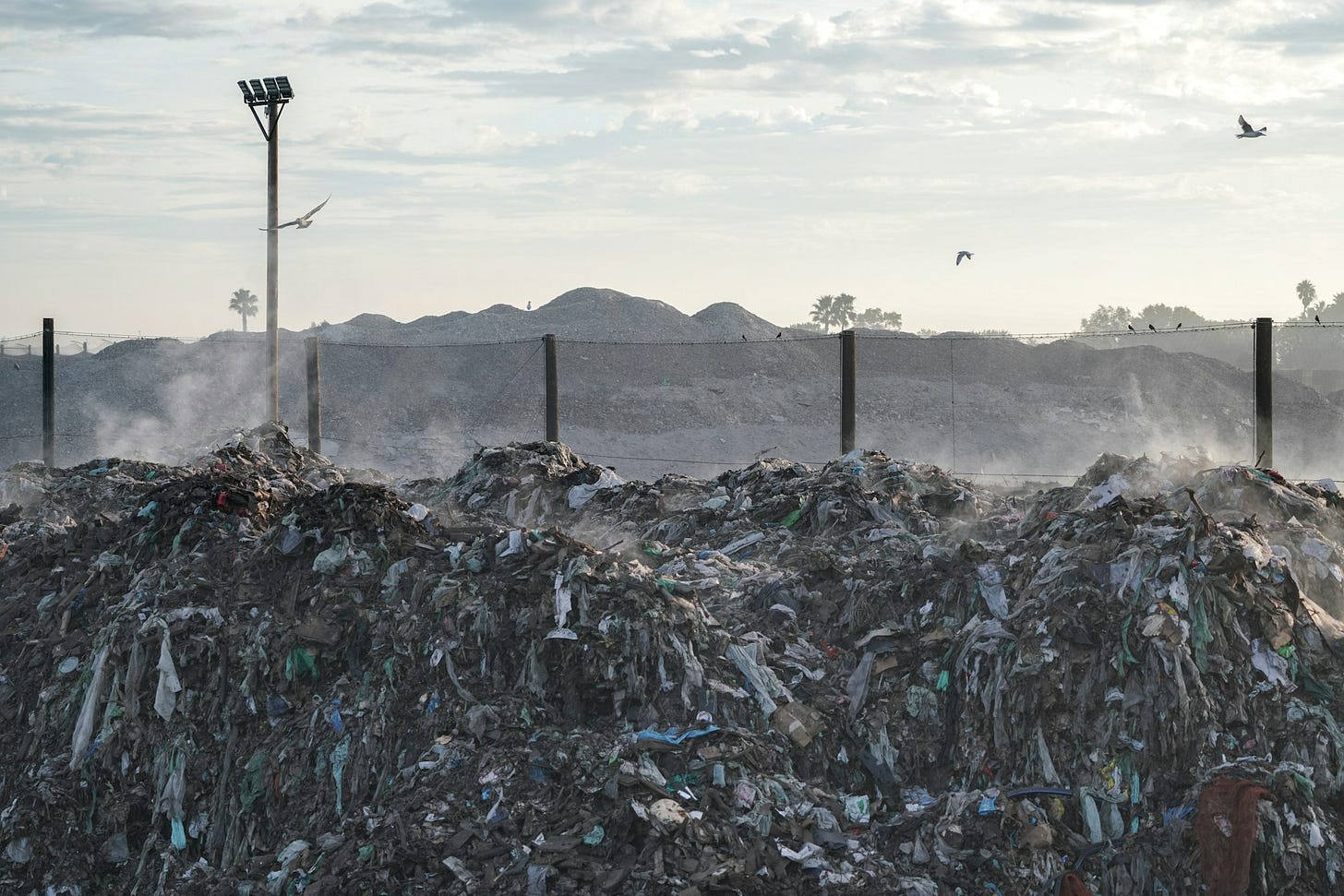Unparalleled Greed: Food Waste in the First World

In last week's post, I discussed how food insecurity is a very large problem for low-income families.
Lack of access to good, healthy produce contributes to poverty, mental and physical health problems, and the loss of dignity for people struggling to keep their families fed.
The Truth About Poverty, Diet, And Quality of Life
With all of that in mind, I'd like you to visualize something. Take a moment and really consider it in detail.
I want you to picture a dumpster sitting behind a grocery store in a major city. A city full of people across the spectrum of wealth, some who have plenty of money to throw around and many who don't.
As you stare at the dumpster, imagine several employees of the store walk out the back with arms full of bags of produce. Perfectly good, vibrant, fresh green lettuce. Cartons of perfectly drinkable milk, just past its expiration date but not the least bit sour. Bags of day-old bread and bagels from the bakery, a little tough, but certainly not moldy.
They open the dumpster, and they throw all of this perfectly edible food in the trash. Enough to provide your household with several meals for the week. They slam the dumpster shut, they lock it -to keep dumpster divers out- and they go back inside to work.
How does this image make you feel?
Food Waste in Agriculture
Before that food even made it to the grocery aisle, it had to be shipped there. It had to be transported from the farm where it was grown, sorted, harvested and stored.
Farms are businesses first, and while we have a rosy image in our heads of the hard-working farmer that's just out there providing food for the masses, we have to keep in mind that they are working for a profit. Agriculture is an incredibly expensive job, and it costs a lot of money just to keep the farm working.
The seeds cost money. Fertilizer costs money. Water costs money. Farm labor costs money. Equipment repairs, fuel, pesticides, replacing broken tools, the costs of transporting everything you harvest...the overhead is incredible.
Since they're out for profit, farmers have to carefully calculate the value of the crops they grow and the potential for revenue it provides. High-value crops are preferred, and that causes its own massive problems.
We humans have a bad habit of thinking we can force nature to do our bidding. For example, did you know that California produces 80% of the world's commercially grown almonds? And did you also know that almonds are an insanely water-intensive crop?
The almond orchards in California use up to 17% of the State's total agricultural water allowance.
All of this during a time of drought and aridification.
We don't grow almonds because they're a nutritious, calorie-dense powerhouse that can keep the world fed. We grow them because they're tasty, and people will pay money for them.
Climate Change In California Is Threatening The World’s Top Almond Producer
So, farmers are looking to grow crops that provide high returns on their investment. Fair enough. What happens when not all of the crop they produce is good enough to sell?
Believe it or not, that's pretty common. There's a complicated system of grading that's used to determine whether food is of high enough quality to make it to the store shelves. Some of that has to do with things like insect damage and disease, which is good. We don't want to eat that.
A large part of food grading has to do with nothing more than aesthetics. And that's where your jaw ought to be falling open.
That's right, guys. If you're holding two perfectly edible cherries, but one of them has a little defect on the surface, the prettier fruit will get a higher price tag.
Fruits and vegetables that are imperfect by the standards of the packing facility they go to, whether that be because of size, color or shape, can be of drastically different value. As a result, the savvy farmer isn't going to waste money on harvesting and transporting the duds.
The savvy farmer tells his workers to only harvest the crops that most closely match the most valuable grading standards and leave the rest to rot in the fields.
But wait, you might say. Why would they do that? There are so many hungry people in the world, so many food banks and soup kitchens and people living with food insecurity! Can't they just donate the imperfect crops instead?
That'd be really nice of them, absolutely. It's a bit more complicated though, because again, they want to recoup the costs of their business. Harvesting and transporting those crops costs money, whether it's to a packing facility or to a food bank.
Luckily, there's a little bit of help available there. Anyone savvy in the ways of tax-deduction has probably already perked up their ears. In the States, since 2015, there have been strides made in the direction of making those donations easier and more affordable for American farmers.
Farmers
Without that incentive, it's more profitable for the farmer to leave that food to rot than to give it to people in need.
Here in Canada, there are some special tax credits for farmers donating to food banks. This varies from province to province, but in general, Canada does allow for this too. Here's an overview of Ontario's system as an example.
Community food program donation tax credit for farmers
Food Waste in the Grocery Aisle
I started this piece by asking you to visualize a grocery store dumpster full of edible food.
The problem of wasting food goes well beyond lost revenue at the farm. It has consequences that go even further than empty bellies and a dinner table left bare, although that's a problem that desperately begs for a better solution.
It has to do with the health of the world as a whole.
When all of those containers of food get thrown into the trash, they don't stay there. Like the rest of the garbage we throw out, it will be picked up by the trash collectors and it will be taken to a landfill.
Leaving food on the ground to rot on the farm is generally benign, at least in terms of pollution. Organic matter rots, and when rotting organic matter is tilled into the soil it breaks down and feeds the roots of the plants for next season's harvest.
But when you pile all that rotting food into a landfill and bury it in plastic, that natural process of rot is interrupted. Instead of going back into the soil, back into the cycle of renewal, that food breaks down into pockets of gases.
Greenhouse gases. Don't take my word for it, check out what Canada's own government has to say about it. According to them, landfills account for a whopping 23% of our national emissions.

Food waste is killing us. Not figuratively, but quite literally.
And there's honestly no excuse for it. We have the infrastructure to prevent this, we have the means to make this food available for donation. It's a general fear of liability and a lack of will that gets in the way.
Most expiration dates that you see in a grocery store are arbitrary. It's the company's best guess on when the food will be freshest, and it honestly only acts as an incentive for you to 'get it while it's hot'.
How many times have you thrown out food from your fridge that smelled fine, but it was past the date and you didn't want to risk it? Grocery stores have the same fear. Someone getting sick from eating one of their products gives them the heeby jeebies.
Everybody's scared of lawsuits these days. Fortunately, lawsuits for food donations almost never happen. And even if they do, it's a pretty safe bet that Good Samaritan laws have your back. In Canada and the United States, you're pretty well covered.
Just like nobody is going to sue you over performing CPR, trying to help families stay fed is not a situation where someone is looking the gift horse in the mouth.
Food Waste Solutions
On the ground level, the best thing we can do is try to reduce food waste at home. Buy less, eat your leftovers instead of throwing them out, and try composting vegetable scraps instead of contributing them to your local landfill.
Soup kitchens and food banks will buy fresh food with monetary donations to help support the community, so donating your spare cash helps them buy those veggies and fruits that could get tossed.
If there are local farms nearby where you live and you're physically able to, you can try contacting them to see if they accept volunteer workers during harvest season. It's hard work, but the less money they need to spend to get in the crop, the less good food gets left on the ground.
You can also look for charitable organizations that work with volunteers to rescue food that's still edible. That food that might get chucked? Charities like Second Harvest can step in to keep it out of the landfill and get it onto the plate.
Food Rescue Charity | Second Harvest
There are many, many good options. I'm sure my readers can think up a few more if they put their heads together in the comment sections. I'd love to see what you guys come up with. Let's get talking!
Solidarity wins.



